News and Site Updates Archive 2009/10/16
Perhaps the world's second-worst crime is boredom; the first is being a bore.
- Cecil Beaton
16 Oct '09 - The term juke box came into use in the United States around 1940, apparently
from the familiar usage "juke joint", derived from the Gullah word "juke" or "joog" meaning disorderly, rowdy, or wicked. This term, like thousands of words in the Gullah language, likely
originated in Western Africa near Sierra Leone. The first jukeboxes were simply wooden boxes with coin slots and a few buttons. Over time they became more and more decorated, using coloured and
then rotating lights, chrome, bubble tubes, ceiling lamps and other visual effects. Many consider the 1940s to be the golden age of jukebox styling with the gothic-like curvaceous electric rainbow
cathedral look. World War II and the Great Depression were over, so new designs and sales choices reflected the festive mood. The first model manufactured after WWII was the Model A, produced by
AMI. Affectionately referred to as Mother of Plastic, it featured large areas of opalescent plastics and coloured gemstones. Styling progressed from plain wooden boxes of the early '30s to
beautiful light shows with marbleised plastic and colour animation in the Wurlitzer 850 Peacock of 1941. But after the US entered the war, metal and plastic were needed for the war effort and jukeboxes
were considered nonessential - so none were produced until 1946. The Wurlitzer model 1015-Bubbler is arguably the most popular jukebox design of all time. Many of these survived into the '50s in
active use and are thus associated with the '50s in pop culture despite their '40s origin because of their unique visual prominence and production volume. Designed by stylist Paul Fuller, it is rumoured
that when entertainment equipment factories were redirected toward the war effort, Paul had more time to focus on æsthetics, resulting in one of the greatest designs in iconic pop culture. Jukeboxes from
the 1940s are called Golden Age because of the yellow catalin plastic. Jukeboxes from the 1950s are called Silver Age because of the
predominant chrome styling. "Rock-Ola" is actually based on the name of company founder David Cullen Rockola and is not a portmanteau of Rock and Victrola. Rock-ola was founded many years before
the term "Rock" was applied to music at all.
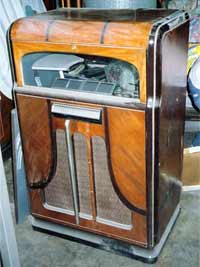
AMI FR
(1934 - 1935) |
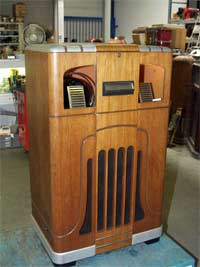
AMI
1936 |
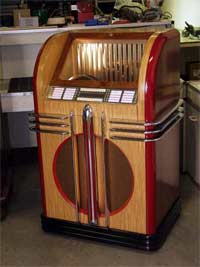
Top Flight
(1935 - 1938) |

Streamliner with Speaker (1938 - 1939) |
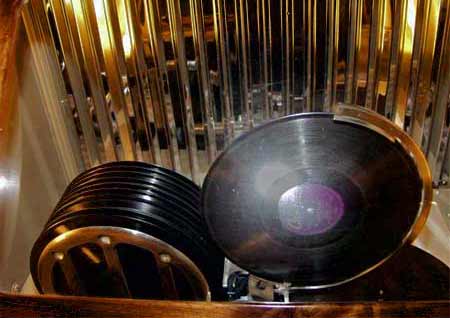
Record Changer
from the Top Flight |
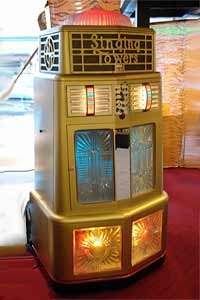
Singing Tower Series "100"
(1939 - 1941) |
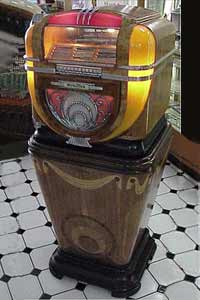
Wurlitzer 71 Countertop
(1940) |
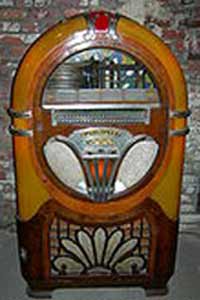
Wurlitzer 24-Disc Changer
(1941) |

Wurlitzer (the icon)
(1946) |
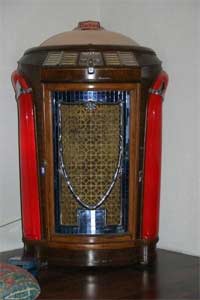
Seeburg Trashcan 147S
(1947) |
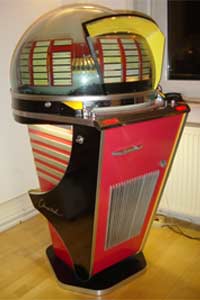
Schweizer Chantal Panoramic
(1959) |
|
 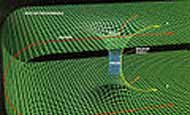 More than a year after an explosion of sparks, soot and
frigid helium shut it down, the world’s biggest and most expensive physics experiment, known as the Large Hadron
Collider, is poised to start up again. In December, if all goes well, protons will smash together in an underground racetrack outside Geneva in a search for forces and particles that reigned during
the first trillionth of a second of the Big Bang. Then it will be time to test one of the most bizarre and revolutionary theories in science - the notion that the troubled collider is being sabotaged by
its own future. Two distinguished physicists suggest that the hypothesised Higgs boson (which physicists hope to produce with the collider) might be so abhorrent to nature that its creation ripples
backward through time and stops the collider before it can make one, like a time traveller who goes back in time to kill his grandfather. [While it is a paradox to go back in time and kill your
grandfather, physicists agree there is no paradox if you go back in time and save him from being hit by a bus.] This malign influence from the future, they argue, could explain why the US Superconducting
Supercollider, also designed to find the Higgs, was cancelled in 1993 after billions of dollars had already been spent, an event so unlikely that one of the physicists calls it an "anti-miracle." When I
first saw this article, I thought they were going to say that a collider searching for the Higgs boson is a natural progression for developing intellectual civilisations and, because the particles it creates
wipe out the planet, advancement of intellectual civilisations is self-limiting and that's why we see no aliens. The extreme age of the universe and its vast number of stars suggest that if the earth is
typical, extraterrestrial life should be common. In an informal discussion in 1950, the physicist Enrico Fermi questioned why, if a
multitude of advanced extraterrestrial civilisations exist in the Milky Way galaxy, evidence such as spacecraft or probes are not seen. Another closely related question is the Great Silence — even
if travel is hard, if life is common, why don't we detect radio transmissions? There are an estimated 250 billion (2.5 x 1011) stars in the Milky Way and 70 sextillion (7 x 1022) in
the visible universe. Even if intelligent life occurs on only a minuscule percentage of planets around these stars, there should still be a great number of civilisations in the Milky Way galaxy
alone. Has no other intelligent life arisen? Or do they just tend to destroy themselves? The "external transmission" or interstellar communicative phase may be the point at which
the system becomes unstable and self-destructs. Various analyses suggest that if using spacecraft that travel at 1/10th the
speed of light, a colonisation wave would take some 50 million years to sweep the galaxy. Others have calculated that it may be closer to 13 billion years - a reasonable explanation as to why we have yet
to spot extraterrestrials? Some of this reminds me of the sci-fi premise that if time travel were ever possible (and a proposed time-travel machine using a traversable wormhole would hypothetically
work), everyone would be changing time all the time so chaos would ensue and derail the future anyway. The future can be SO complicated. More than a year after an explosion of sparks, soot and
frigid helium shut it down, the world’s biggest and most expensive physics experiment, known as the Large Hadron
Collider, is poised to start up again. In December, if all goes well, protons will smash together in an underground racetrack outside Geneva in a search for forces and particles that reigned during
the first trillionth of a second of the Big Bang. Then it will be time to test one of the most bizarre and revolutionary theories in science - the notion that the troubled collider is being sabotaged by
its own future. Two distinguished physicists suggest that the hypothesised Higgs boson (which physicists hope to produce with the collider) might be so abhorrent to nature that its creation ripples
backward through time and stops the collider before it can make one, like a time traveller who goes back in time to kill his grandfather. [While it is a paradox to go back in time and kill your
grandfather, physicists agree there is no paradox if you go back in time and save him from being hit by a bus.] This malign influence from the future, they argue, could explain why the US Superconducting
Supercollider, also designed to find the Higgs, was cancelled in 1993 after billions of dollars had already been spent, an event so unlikely that one of the physicists calls it an "anti-miracle." When I
first saw this article, I thought they were going to say that a collider searching for the Higgs boson is a natural progression for developing intellectual civilisations and, because the particles it creates
wipe out the planet, advancement of intellectual civilisations is self-limiting and that's why we see no aliens. The extreme age of the universe and its vast number of stars suggest that if the earth is
typical, extraterrestrial life should be common. In an informal discussion in 1950, the physicist Enrico Fermi questioned why, if a
multitude of advanced extraterrestrial civilisations exist in the Milky Way galaxy, evidence such as spacecraft or probes are not seen. Another closely related question is the Great Silence — even
if travel is hard, if life is common, why don't we detect radio transmissions? There are an estimated 250 billion (2.5 x 1011) stars in the Milky Way and 70 sextillion (7 x 1022) in
the visible universe. Even if intelligent life occurs on only a minuscule percentage of planets around these stars, there should still be a great number of civilisations in the Milky Way galaxy
alone. Has no other intelligent life arisen? Or do they just tend to destroy themselves? The "external transmission" or interstellar communicative phase may be the point at which
the system becomes unstable and self-destructs. Various analyses suggest that if using spacecraft that travel at 1/10th the
speed of light, a colonisation wave would take some 50 million years to sweep the galaxy. Others have calculated that it may be closer to 13 billion years - a reasonable explanation as to why we have yet
to spot extraterrestrials? Some of this reminds me of the sci-fi premise that if time travel were ever possible (and a proposed time-travel machine using a traversable wormhole would hypothetically
work), everyone would be changing time all the time so chaos would ensue and derail the future anyway. The future can be SO complicated.
In 1991, during Australian Senator Bob Collins' term as Minister for Shipping, the Greek oil tanker Kirki lost its
bow in rough seas in Australian waters and 17,280 tons of light crude oil were spilled. The tanker was subsequently towed away from the coastline and salvaged. Collins' response to this was the
subject of a famous parody interview by satirists John Clarke and Bryan Dawe, in which Clarke, playing Collins, repeatedly refers to the
ship of which "the front fell off." Collins died by what was ruled suicide (an overdose of prescription drugs) in 2007 aged 61 with multiple charges of child sex abuse in both the Northern Territory and
ACT pending.
 |
| The towers of the Brooklyn Bridge (opened 1883)
were built atop caissons, large wooden boxes with no bottoms towed into position and sunk to the river bottom. Compressed air was pumped into the chambers to keep water from rushing in; men
inside dug away at mud and bedrock at the bottom of the river. As the stone towers were built atop the caissons, the men beneath (dubbed "sand hogs") kept digging ever deeper, eventually reaching
solid bedrock. Digging stopped and caissons were filled with concrete, thus becoming foundations for the bridge. Today the Brooklyn caisson sits 44 feet below water but the caisson on the
Manhattan side had to be dug deeper - 78 feet below water - and at that, it doesn't rest on bedrock, but on compacted sand, the engineer guessing that hard sand would do (necessary because his men were
starting to die or go deaf coming up from such great depth). As the bridge hasn't shifted an inch in over a century of hard use, this was apparently okay. Work inside the caisson was
exceedingly difficult. The atmosphere was misty and, as work occurred before electric lighting, the only illumination was gas lamps, meaning it was very
dim. Caisson disease is so named because it appeared in construction workers when they left the compressed
atmosphere of the caisson and rapidly re-entered normal (decompressed) atmospheric conditions. (It is caused by the same processes as decompression sickness in divers.) The Brooklyn Bridge
had several workers killed or permanently injured by caisson disease during its construction, including the designer's son, Washington
Roebling. No power tools were used in the bridge's construction. |
  Does the sun rotate? Yes. We know this
because all sunspots move across its face. Observations indicate that the sun does not rotate as a solid body, but spins differentially, rotating faster at the equator (gas giants Jupiter and Saturn do
the same). The sunspot movement indicates that the sun rotates once every 27 days at the equator and once in 31 days at the poles. If you map the location of the spots on the sun’s surface over the
course of a solar cycle, the pattern they make is shaped like a butterfly... US Supreme Court Justice Antonin Scalia,
in 2006, wrote that, in the modern judicial system there has not been a single case - not one - in which it is clear that a person was executed for a crime he did not commit. If such an event had
occurred in recent years, we would not have to hunt for it; the innocent's name would be shouted from the rooftops. Well, shout the
name of Todd Willingham - because he was innocent but the State of Texas executed him for arson/murder on 17 February 2004. His 3 young daughters died in a fire in the family home two days before
Christmas in 1991. Todd, who had to be restrained by police from going back inside the burning house, professed his innocence from the time of his arrest until he was strapped down on the execution
gurney, refusing the offer of life imprisonment in exchange for pleading guilty. On 25 August 2009, Dr Craig Beyler, an investigator hired by the Texas Forensic Science Commission to review the
Willingham case, released his report in which he found that a finding of arson could not be sustained by scientific analysis. He concluded that the fire in the Willingham case was accidental - there was
no arson so there was no crime. The judge disagreed. The fact that Todd had tattoos and liked heavy metal music was clear evidence that he was a devil worshipper. Ergo, he was guilty and any
scientific evidence to the contrary was meaningless. The judge also said that the fact that Todd never confessed was proof of his guilt because Todd never told the truth about anything - so if he
said he didn't do it, that meant he really did. Get it? Does the sun rotate? Yes. We know this
because all sunspots move across its face. Observations indicate that the sun does not rotate as a solid body, but spins differentially, rotating faster at the equator (gas giants Jupiter and Saturn do
the same). The sunspot movement indicates that the sun rotates once every 27 days at the equator and once in 31 days at the poles. If you map the location of the spots on the sun’s surface over the
course of a solar cycle, the pattern they make is shaped like a butterfly... US Supreme Court Justice Antonin Scalia,
in 2006, wrote that, in the modern judicial system there has not been a single case - not one - in which it is clear that a person was executed for a crime he did not commit. If such an event had
occurred in recent years, we would not have to hunt for it; the innocent's name would be shouted from the rooftops. Well, shout the
name of Todd Willingham - because he was innocent but the State of Texas executed him for arson/murder on 17 February 2004. His 3 young daughters died in a fire in the family home two days before
Christmas in 1991. Todd, who had to be restrained by police from going back inside the burning house, professed his innocence from the time of his arrest until he was strapped down on the execution
gurney, refusing the offer of life imprisonment in exchange for pleading guilty. On 25 August 2009, Dr Craig Beyler, an investigator hired by the Texas Forensic Science Commission to review the
Willingham case, released his report in which he found that a finding of arson could not be sustained by scientific analysis. He concluded that the fire in the Willingham case was accidental - there was
no arson so there was no crime. The judge disagreed. The fact that Todd had tattoos and liked heavy metal music was clear evidence that he was a devil worshipper. Ergo, he was guilty and any
scientific evidence to the contrary was meaningless. The judge also said that the fact that Todd never confessed was proof of his guilt because Todd never told the truth about anything - so if he
said he didn't do it, that meant he really did. Get it?
There were 441 offenders executed in the state of Texas from 7 December 1982 - 22 September 2009. Their "final words" are solicited and recorded. Collectively, they fall into these main
categories:
 | No statement. |
|
 | Curses. |
|
 | I'm glad I did it. |
|
 | I'm innocent. |
|
 | I didn't mean to. |
|
 | I'm guilty but I've changed. |
|
 | Give Mama (and/or Dad and/or my kids) my love. |
|
 | I've found religion and I'm going to the Lord. |
|
 | I deserve this. |
|
 | I'm sorry - please forgive me. |
|
 | Tell my victim's family I'm sorry for the pain I caused. |
|
 | I'll be fine. |
 | I'll see you later. |
|
I read all of them (dunno why) and these were the ones that stuck with me:
Doyle Skillern #518: I pray that my family will rejoice and will forgive, thank
you.
Henry Porter #551: What I want people to know is that they call me a cold-blooded killer
when I shot a man that shot me first. The only thing that convicted me was that I am a Mexican and he was a police officer. People hollered for my life, and they are to have my life
tonight. People never hollered for the life of the policeman that killed a 13-year-old boy handcuffed in the back seat of a police car. People never hollered for the life of a Houston police
officer who beat up and drowned Jose Campo Torres and threw his body into the river. You call that equal justice? This is your equal justice. This is America’s equal justice. A
Mexican’s life is worth nothing. When a policeman kills someone he gets a suspended sentence or probation. When a Mexican kills a police officer this is what you get. From there you call me
a cold-blooded murderer. I didn’t tie anyone to a stretcher. I didn’t pump any poison into anybody’s veins from behind a locked door. You call this justice - I call this and your society a
bunch of cold-blooded murderers. I don’t say this with any bitterness or anger, I just say this with truthfulness. I hope God forgives me for all my sins. I hope that God will be as
merciful to society as he has been to me. I’m ready, Warden.
Charles William Bass #662: I deserve this. Tell everyone I said goodbye.
Jessie Gutierrez #971: I just love everybody, and that’s it.
Douglas Roberts: Yes sir, Warden. Okay I've been hanging around this popsicle
stand way too long. Before I leave, I want to tell you all: when I die, bury me deep, lay two speakers at my feet, put some headphones on my head and rock and roll me when I'm dead. I'll see you
in heaven someday. That's all, Warden.
Jonathan Moore: I'm sorry, I didn't know the man but for a few seconds before I shot
him. It was done out of fear, stupidity, and immaturity. It wasn't until I got locked up and saw the newspaper - I saw his face and his smile and I knew he was a good man. I'm sorry for all
your family and my disrespect - he deserved better. We're done, Warden.
Derrick O'Brien: I'm sorry. I've always been sorry. It's the worst mistake
I ever made in my whole life - not because I'm here, but because of what I did and I hurt a lot of people - you, and my family. I'm sorry; I've always been sorry. I AM sorry. You look after
each other. I love you all. Be there for one another. All right. But I'm sorry; very sorry. I love you. too. All right.
 |
|
In Lhasa, Tibet, where the oxygen content is just 60% of that of most of Earth, a "natural oxygen bar" is
highly prized by residents. Located northwest of the historic Potala Palace, Lhalu Wetland is a tranquil garden in a noisy city, the highest wetland in the world with an average altitude of 3,645
metres. Lhalu occupies an area of 6.6 square kilometres and accounts for 11.7% of the city's total area. The wetland is very important in a place deficient of breathable air because it
generates 61,000 tons of oxygen and absorbs 78,800 tons of carbon dioxide each year. It also plays an important role in safeguarding ecological balance, preserving biodiversity and improving the
climate and environment of Lhasa by adding humidity to the city and providing a habitat for a wide range of birds. |
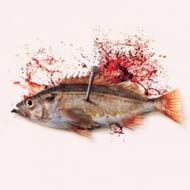  Our oceans
have been the victims of a giant Ponzi scheme, waged with callousness by the world’s fisheries. In the 1950s, as operations became increasingly industrialised - onboard refrigeration, acoustic
fish-finders, (and now) GPS - they depleted stocks of cod, hake, flounder, sole, and halibut in the Northern Hemisphere; then the fleets moved southward, to the coasts of developing nations and, ultimately,
all the way to Antarctica, searching for icefishes and rock cods, and, more recently, small shrimplike krill. As the bounty of coastal waters dropped, fisheries moved further offshore, to deeper waters
and, finally, as larger fish disappeared, began to catch smaller and uglier fish - ones never before considered fit to eat. Many were renamed for the market: the suspicious slimehead became the delicious
orange roughy and the worrisome Patagonian toothfish became the wholesome Chilean sea bass. Others, like the homely hoki, were cut up so they could be sold sight-unseen as fish sticks and filets in
fast-food restaurants and the frozen-food aisle. Just as a Ponzi scheme will collapse once the pool of potential investors has been drained, so too will the fishing industry collapse as oceans are
drained of life. Unfortunately, it is not just the future of the fishing industry that is at stake, but also the continued health of the world’s largest ecosystem. One thing is clear: fish are in
dire peril and if they are, then so are we (unless you find jellyfish palatable for dinner)... Eat hamburger
instead of fish, you say? The frozen hamburgers that the Smiths ate, which were made by the food giant Cargill, were labelled "American Chef’s Selection Angus Beef Patties." Yet confidential grinding
logs and other Cargill records show that the hamburgers were made from a mix of slaughterhouse trimmings and a mash-like product derived from scraps that were ground together at a plant in Wisconsin. The
ingredients came from slaughterhouses in Nebraska, Texas and Uruguay, and from a South Dakota company that processes fatty trimmings and treats them with ammonia to kill bacteria. Unwritten agreements
between some companies appear to stand in the way of ingredient testing. Many big slaughterhouses sell only to grinders who agree not to test the shipments for E coli, according to officials at two large
grinding companies. Slaughterhouses fear one grinder’s discovery of E coli will set off a recall of ingredients they sold to others. The potential for contamination is present every step of the
way, according to workers and federal inspectors. The cattle often arrive with smears of feedlot fæces that harbour the E coli pathogen and the hide must be removed carefully to keep it off the meat. Our oceans
have been the victims of a giant Ponzi scheme, waged with callousness by the world’s fisheries. In the 1950s, as operations became increasingly industrialised - onboard refrigeration, acoustic
fish-finders, (and now) GPS - they depleted stocks of cod, hake, flounder, sole, and halibut in the Northern Hemisphere; then the fleets moved southward, to the coasts of developing nations and, ultimately,
all the way to Antarctica, searching for icefishes and rock cods, and, more recently, small shrimplike krill. As the bounty of coastal waters dropped, fisheries moved further offshore, to deeper waters
and, finally, as larger fish disappeared, began to catch smaller and uglier fish - ones never before considered fit to eat. Many were renamed for the market: the suspicious slimehead became the delicious
orange roughy and the worrisome Patagonian toothfish became the wholesome Chilean sea bass. Others, like the homely hoki, were cut up so they could be sold sight-unseen as fish sticks and filets in
fast-food restaurants and the frozen-food aisle. Just as a Ponzi scheme will collapse once the pool of potential investors has been drained, so too will the fishing industry collapse as oceans are
drained of life. Unfortunately, it is not just the future of the fishing industry that is at stake, but also the continued health of the world’s largest ecosystem. One thing is clear: fish are in
dire peril and if they are, then so are we (unless you find jellyfish palatable for dinner)... Eat hamburger
instead of fish, you say? The frozen hamburgers that the Smiths ate, which were made by the food giant Cargill, were labelled "American Chef’s Selection Angus Beef Patties." Yet confidential grinding
logs and other Cargill records show that the hamburgers were made from a mix of slaughterhouse trimmings and a mash-like product derived from scraps that were ground together at a plant in Wisconsin. The
ingredients came from slaughterhouses in Nebraska, Texas and Uruguay, and from a South Dakota company that processes fatty trimmings and treats them with ammonia to kill bacteria. Unwritten agreements
between some companies appear to stand in the way of ingredient testing. Many big slaughterhouses sell only to grinders who agree not to test the shipments for E coli, according to officials at two large
grinding companies. Slaughterhouses fear one grinder’s discovery of E coli will set off a recall of ingredients they sold to others. The potential for contamination is present every step of the
way, according to workers and federal inspectors. The cattle often arrive with smears of feedlot fæces that harbour the E coli pathogen and the hide must be removed carefully to keep it off the meat.
Anthony and Lesley Arambula say an armed intruder "crashed through the front window" of their home last year and ran into one of their son's bedrooms. Worried about his son who was still inside his
room, Anthony "held the intruder calmly at gunpoint" and called 911. Phoenix, Arizona Police officers already in the neighbourhood
approached the house. Lesley told the Sergeant that her husband was inside holding the intruder at gunpoint but he failed to pass that information to the Officer. Inside the house, the Officer shot
Anthony 6 times in the back while he was still on the phone with the 911 operator - twice after he was lying on the ground. Anthony told him, "You just killed ... you just killed the homeowner. The
bad guy is in there." The Officer "admitted that it was only after Tony was lying, bullet-riddled, on the ground that he assessed the situation. The 911 tape continued to record what happened even
after the Officer unloaded his weapon into Tony. Still not knowing about the recording, the Sergeant interrupted the Officer's admission and apology with his assurance that the cover-up would commence:
'That's all right. Don't worry about it. I got your back. We clear?'" The Sergeant asked the Officer where Tony's gun was at the time he had opened fire. The Officer admitted that
he didn't know: "I heard screaming and I fired." The Officer later told a police internal affairs investigator that Anthony had pointed his gun in his direction, "in the 'ready' position."
 |
 |
|
"We're Moving. It's the crab's house, now." Coconut crabs are the biggest land-based
arthropod. Found in areas around the Indian Ocean and central areas of the Pacific, their characteristic feature is pincers so strong they can crack coconuts - hence their name. The front
pair of legs are the large claws. The next two pairs have claws that give it the capability to climb coconut trees. The last small pair of legs are used to clean the breathing
organs. An adult coconut crab can have a 1-metre leg span and body length of 40 centimetres. It can weigh up to 17 kilograms. Related to hermit crabs, their moulting phase can last up to a
month. Some live underground, others in rock crevices; they are nocturnal. |
The Japanese spider crab, Macrocheira kaempferi, is the largest known arthropod; fully grown it
can reach a leg span of almost 4 metres (13 feet), a body size of up to 37 centimetres (15 inches) and a weight of up to 20 kilograms (44 pounds).
The crab's natural habitat is on the bottom of the Pacific Ocean (some 300 to 400 metres deep) around Japan, where it feeds on dead animals and shellfish. It is believed to have a life expectancy
of up to 100 years.
It has 10 legs and a gentle disposition. |
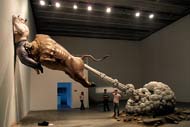  The sculpture What You see Might Not Be Real, by Chen
Wenling is a critique of the global financial crisis, with the bull representing Wall Street and the man pinned to the wall representing Bernard Madoff. (Ng Han Guan/Associated Press)... What do
these high-profile disasters have in common: World War I, Vietnam, war in Iraq, collapse of the banking system, and under preparedness for natural disasters such as Hurricane Katrina? The answer is:
they have all been blamed on overconfidence. Studies have shown that some people have an exaggerated sense of their own
capabilities, an illusion that they have control over uncontrollable events and are invulnerable to risk. Most people believe they are above-average drivers, a statistical impossibility [unless "average"
is used to mean "median"]. Most of us are overconfident in one way or another - but how can this have evolved when overconfidence can lead to destruction and loss? A mathematical model of the way
overconfident individuals compete against ordinary individuals shows a clear advantage in overconfidence. In fact, if the potential reward is at least twice as great as the cost of competing, then
overconfidence is the best strategy, advantageous on average because it boosts ambition, resolve, morale, and persistence. In other words, overconfidence is the best way to maximise benefit over cost
when risks are uncertain. The greater the risk, the more overconfident individuals should become. Overconfidence will be particularly prevalent in domains where perceived prize value sufficiently
exceeds expected competition costs. These domains include international relations, where events are complex and distant and involve foreign cultures and languages; new technologies such as the Internet
bubble; and the banking industry, where complex financial instruments abound... "If you think that it’s the lack of recreational facilities and entertainment options that have made you an anti-social,
overbearing, overweight semi-alcoholic then think again. Life is always what you make it." Slam! The phone line goes dead and it’s just you, your hangover, your choices, and of course your big gut. The sculpture What You see Might Not Be Real, by Chen
Wenling is a critique of the global financial crisis, with the bull representing Wall Street and the man pinned to the wall representing Bernard Madoff. (Ng Han Guan/Associated Press)... What do
these high-profile disasters have in common: World War I, Vietnam, war in Iraq, collapse of the banking system, and under preparedness for natural disasters such as Hurricane Katrina? The answer is:
they have all been blamed on overconfidence. Studies have shown that some people have an exaggerated sense of their own
capabilities, an illusion that they have control over uncontrollable events and are invulnerable to risk. Most people believe they are above-average drivers, a statistical impossibility [unless "average"
is used to mean "median"]. Most of us are overconfident in one way or another - but how can this have evolved when overconfidence can lead to destruction and loss? A mathematical model of the way
overconfident individuals compete against ordinary individuals shows a clear advantage in overconfidence. In fact, if the potential reward is at least twice as great as the cost of competing, then
overconfidence is the best strategy, advantageous on average because it boosts ambition, resolve, morale, and persistence. In other words, overconfidence is the best way to maximise benefit over cost
when risks are uncertain. The greater the risk, the more overconfident individuals should become. Overconfidence will be particularly prevalent in domains where perceived prize value sufficiently
exceeds expected competition costs. These domains include international relations, where events are complex and distant and involve foreign cultures and languages; new technologies such as the Internet
bubble; and the banking industry, where complex financial instruments abound... "If you think that it’s the lack of recreational facilities and entertainment options that have made you an anti-social,
overbearing, overweight semi-alcoholic then think again. Life is always what you make it." Slam! The phone line goes dead and it’s just you, your hangover, your choices, and of course your big gut.
China will soon be the world's largest economy
and largest creditor nation, a position enjoyed by a pre-eminent America in the 1950s. China will also be the largest consumer of oil, which will help push trading in it and other commodities towards a
"basket" of currencies. Now America is the world's greatest debtor, she can no longer sustain her role as protector of the world's only reserve currency in the long term. The humbling of Wall
Street was proof that the American system was not invincible. Suddenly, a G20 embracing China, India and the other emerging powers is the only forum that matters. China has helped bail out our
banks. Spats with the Americans and Europeans are set to grow more bitter. Next will come an increasing US resentment at the vast debts built up with China, and, in turn, Chinese nervousness about
their long-term worth. And that is the paradox. China holds approaching $3 trillion in dollar assets, so she cannot afford to see the dollar collapse. Longer term, China does want to become
less reliant on the dollar as a place to keep savings. America needs China to buy Treasury bills and China needs America to buy exports. They are like two drunken giants leaning on each
other. Yet a sobering reckoning of some sorts seems inevitable; it is difficult to see how both can be winners. The decline of American economic power linked to the current global recession was acknowledged by World Bank
president Robert Zoellick. "One of the legacies of this crisis may be a recognition of changed economic power relations," he said. But it is China's extraordinary new financial power – along with
past anger among oil-producing and oil-consuming nations at America's ability to interfere in the international financial system – which has prompted the latest discussions. China imports 60% of its oil,
much of it from the Middle East and Russia. The Chinese have oil production concessions in Iraq – blocked by the US until this year – and since 2008 have held an US$8 billion agreement with Iran to
develop refining capacity and gas resources. China has oil deals in Sudan (where it has substituted for US interests) and has been negotiating for oil concessions with Libya. Furthermore, Chinese
exports to the region now account for no fewer than 10% of all Middle East imports, including cars, weapon systems, food, clothes, even dolls.
 |
 |
 |
|
The green area shows the Red River of the North's flood plain. Floods of March 2009 went
down in the record books as the most severe Fargo, North Dakota has experienced in its history. The Red River reached a record high of 40.82 feet as it flowed through Fargo (flood stage for the
river is 18 feet). The Red River of the North, which forms the border between North Dakota and Minnesota, has a long history of severe floods. In the US, the Red River lies in a trough
shaped by continental glaciers about 10,000 years ago. |
Held in place by reinforced levees, the swollen Red River snakes through Fargo, North Dakota,
and Moorhead, Minnesota. The river’s usual s-shaped curves north and south of Interstate 94 are swallowed in a bulge of water. All bridges were closed. |
Of course, the neighbourhood, without those great levees, got it even worse... Snow that covered the region was both the cause of the flood and the reason water stopped rising. The river flooded
as melting snow from a deeper-than-average snowpack filled the basin but the return of cold, wintry weather finally slowed the rise. |
  Over the centuries, there have been 12 layers of people buried within the confines of the Old Jewish cemetery in Prague. It is estimated that 12,000 tombstones are presently visible and there have
been as many as 100,000 burials in all. (Via Presurfer)... During spring in Denmark, at
approximately half an hour before sunset, flocks of more than a million European starlings (Sturnus
vulgaris) gather from all corners to join in incredible amorphous, self-organising formations. This phenomenon is called Black Sun and can be witnessed in early spring throughout the marshlands of
western Denmark, from March until the middle of April. Starlings migrate from the south and spend the day in meadows gathering food, sleeping in the reeds during the night... Most people think we
do all that can be done to keep roads safe. They're wrong. Road
traffic injuries kill more than a million people a year worldwide, including 40,000 a year in the US alone. We'll continue to have drivers who are too young, too old, too distracted, or too bold, but
we can change roads so they help protect both drivers and pedestrians. Examples include rumble strips, speed bumps, barriers down the centre of two-lane roads (even polyester film supported by closely
spaced plastic poles can keep cars from crossing the median) and replacing traffic signals (because that yellow light causes many drivers to speed up) with traffic circles... A YouTube video entitled
"Chinese Football Supporters" may not sound like it would be too interesting, but actually it really
is... Epidemiologists in Pennsylvania found that, on average, guns do not protect those who possessed
them from being shot in an assault. The study estimated that people with a gun were 4.5 times more likely to be shot when assaulted than those not possessing a gun. This study was designed to
resolve the long-standing debate about whether guns are protective or perilous - does a firearm safeguard against harm or promote a false sense of security? What researchers found was alarming – almost
5 Philadelphians are shot every day; and about 1 of these 5 die. The research team concluded that, although successful defensive gun uses are possible and do occur each year, the chances of success are
low. People should rethink possession of guns or, at least, understand that regular possession necessitates careful safety countermeasures. Urban residents who see gun possession as a defence
against a dangerous environment should thoughtfully reconsider. (The US has at least one gun for every adult.) Over the centuries, there have been 12 layers of people buried within the confines of the Old Jewish cemetery in Prague. It is estimated that 12,000 tombstones are presently visible and there have
been as many as 100,000 burials in all. (Via Presurfer)... During spring in Denmark, at
approximately half an hour before sunset, flocks of more than a million European starlings (Sturnus
vulgaris) gather from all corners to join in incredible amorphous, self-organising formations. This phenomenon is called Black Sun and can be witnessed in early spring throughout the marshlands of
western Denmark, from March until the middle of April. Starlings migrate from the south and spend the day in meadows gathering food, sleeping in the reeds during the night... Most people think we
do all that can be done to keep roads safe. They're wrong. Road
traffic injuries kill more than a million people a year worldwide, including 40,000 a year in the US alone. We'll continue to have drivers who are too young, too old, too distracted, or too bold, but
we can change roads so they help protect both drivers and pedestrians. Examples include rumble strips, speed bumps, barriers down the centre of two-lane roads (even polyester film supported by closely
spaced plastic poles can keep cars from crossing the median) and replacing traffic signals (because that yellow light causes many drivers to speed up) with traffic circles... A YouTube video entitled
"Chinese Football Supporters" may not sound like it would be too interesting, but actually it really
is... Epidemiologists in Pennsylvania found that, on average, guns do not protect those who possessed
them from being shot in an assault. The study estimated that people with a gun were 4.5 times more likely to be shot when assaulted than those not possessing a gun. This study was designed to
resolve the long-standing debate about whether guns are protective or perilous - does a firearm safeguard against harm or promote a false sense of security? What researchers found was alarming – almost
5 Philadelphians are shot every day; and about 1 of these 5 die. The research team concluded that, although successful defensive gun uses are possible and do occur each year, the chances of success are
low. People should rethink possession of guns or, at least, understand that regular possession necessitates careful safety countermeasures. Urban residents who see gun possession as a defence
against a dangerous environment should thoughtfully reconsider. (The US has at least one gun for every adult.)
For most of the last two decades, the Rondout-West Branch tunnel — 45 miles long, 13.5 feet wide, up to 1,200 feet
below ground and responsible for ferrying half of New York City’s water supply from reservoirs in the Catskill Mountains — has been leaking some 20 million gallons a day - except recently, when on
some days it has lost up to 36 million gallons. Unfortunately, repairs will take 5 years and cost $240 million. Six deep-sea divers live for more than a month in a sealed 24-foot tubular
pressurised tank complete with showers, a tv and a Nerf basketball hoop, breathing 97.5% helium and 2.5% oxygen (so their high-pitched squeals are all but unintelligible). They leave the tank only to
transfer directly to a diving bell lowered 70 stories into the earth, where they work 12-hour shifts, with each man taking a 4-hour turn hacking away at concrete to expose the valve. New York has one of
the world’s most complex water systems. Eight million residents in the city, and another million upriver daily consume 1.2 billion gallons of water. Via Pruned.)
 |
 |
|
While wave clouds like this are not unusual, this particular pattern over the Aral Sea is
highly unusual. The clouds conform exactly to the shape of the western shore. One possibility is that the shoreline is elevated above the water. The Aral Sea has been steadily
shrinking. What remains is the deepest portions of the sea. It is possible that the western shore is distinctly defined, and that there is a drop to the surface of the
water. This change in elevation would cause the surface air to drop suddenly, which could initiate wave motion. |
Cold northerly winds (perhaps from Greenland) encounter moist air over the Greenland Sea and their meeting generates dozens of parallel rows of clouds, commonly called
"cloud streets," in the skies around the island of Jan Mayen. Like water in a stream as it flows
around a boulder, the wind diverges on the north side of the island and converges on the south side - so downwind of Jan Mayen, the air swirls into a string of spiralling eddies known as von
Karman vortices. |
|
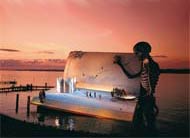 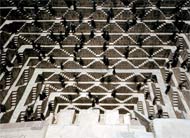 Singers perform on a giant stage on Lake
Constance during a rehearsal of Giuseppe Verdi’s opera Ein Maskenball. The design of the stage shows Death reading the Book of Life. One German performance in 2008 rebuked US
capitalism by parading naked retirees on a set of the World Trade Center's ruins and offered a female singer with a Hitler moustache saluting the audience. "One has to introduce new elements," said the
director. "The naked stand for people without means, the victims of capitalism, the underclass, who don't have anything any more," he explained. [I suspect there may be more conventional ways to
hold audience attention]... In southwestern Gujarat, in the late 6th and early 7th centuries, anonymous masons dug deep trenches into the earth to reach dependable, year-round groundwater. Building
upward, they lined the walls of the trenches with huge stone blocks, laid without mortar, and paved the slope of each trench with stone stairs leading up from the water. Thus were built the first stepwells - visible architecture that gave access to an invisible landscape of
underground aquifers. A stepwell simply penetrates an aquifer; it is filled by seepage. There is no obvious water current - the fall and rise of the water level at the bottom of the well reflects
the droughts and deluges at the surface. A long staircase, punctuated with landings, leads down to the well at the bottom. When the water table is high during and shortly after the monsoon, the
visitor descends only a few steps to drink or bathe or fill the household vessel; when the water is low, she must descend farther, as deep as 9 stories down, to where the final flight disappears into clear,
dark water. At each landing is an open porch, supported by columns and protected from exposure to the broiling sun, where the visitor can pause to enjoy a quiet moment in the cool shade. A stepwell
was host not only to people but also to entire communities of bees, fish, lizards, palm squirrels, parrots, pigeons, and turtles. With the onset of the British Raj in India in the 19th century - and with
it, the installation of pipes and taps for drawing and distributing water - stepwells fell on hard times. To the British, stepwells were a sanitary disaster. As for the stepwells themselves, some
became repositories for trash and old tires, a few became the basements of new buildings, others became latrines. In Mehmadabad, Gujarat, a large apartment block collapsed into a stepwell near the
market. Much more destructive to the stepwells in the long run have been powerful pumps and increased irrigation, both of which can lower the water table until a stepwell no longer reaches it, or until
salt, saltpetre, or petroleum contaminate the water, permanently ruining its taste. Singers perform on a giant stage on Lake
Constance during a rehearsal of Giuseppe Verdi’s opera Ein Maskenball. The design of the stage shows Death reading the Book of Life. One German performance in 2008 rebuked US
capitalism by parading naked retirees on a set of the World Trade Center's ruins and offered a female singer with a Hitler moustache saluting the audience. "One has to introduce new elements," said the
director. "The naked stand for people without means, the victims of capitalism, the underclass, who don't have anything any more," he explained. [I suspect there may be more conventional ways to
hold audience attention]... In southwestern Gujarat, in the late 6th and early 7th centuries, anonymous masons dug deep trenches into the earth to reach dependable, year-round groundwater. Building
upward, they lined the walls of the trenches with huge stone blocks, laid without mortar, and paved the slope of each trench with stone stairs leading up from the water. Thus were built the first stepwells - visible architecture that gave access to an invisible landscape of
underground aquifers. A stepwell simply penetrates an aquifer; it is filled by seepage. There is no obvious water current - the fall and rise of the water level at the bottom of the well reflects
the droughts and deluges at the surface. A long staircase, punctuated with landings, leads down to the well at the bottom. When the water table is high during and shortly after the monsoon, the
visitor descends only a few steps to drink or bathe or fill the household vessel; when the water is low, she must descend farther, as deep as 9 stories down, to where the final flight disappears into clear,
dark water. At each landing is an open porch, supported by columns and protected from exposure to the broiling sun, where the visitor can pause to enjoy a quiet moment in the cool shade. A stepwell
was host not only to people but also to entire communities of bees, fish, lizards, palm squirrels, parrots, pigeons, and turtles. With the onset of the British Raj in India in the 19th century - and with
it, the installation of pipes and taps for drawing and distributing water - stepwells fell on hard times. To the British, stepwells were a sanitary disaster. As for the stepwells themselves, some
became repositories for trash and old tires, a few became the basements of new buildings, others became latrines. In Mehmadabad, Gujarat, a large apartment block collapsed into a stepwell near the
market. Much more destructive to the stepwells in the long run have been powerful pumps and increased irrigation, both of which can lower the water table until a stepwell no longer reaches it, or until
salt, saltpetre, or petroleum contaminate the water, permanently ruining its taste.
Every so often, commercial pilots and other professionals whose jobs require them to be highly vigilant have to take something called the maintenance of wakefulness test. They must sit in a comfy
chair in a dimly-lit room and stay awake for 40 minutes, a procedure repeated 4 times over the course of 8 hours. If they should drop off, this is detected by EEG, eye movement and jaw
slackness. This is a fairly crude measure and people whose job is on the line tend to be highly motivated to stay awake. A more sensitive test has now been developed - a test of reaction time in which subjects have
to repeatedly press a button in response to a light going on. This psychomotor vigilance test is very sensitive to instability in the boundaries between wakefulness and sleep. A version went up to
the International Space Station so astronauts could put it through its paces. If it accurately reflects ability to do the job, it may soon be routinely applied to pilots, nuclear power station operators
and others in life-or-death positions.
 
30 creative resumes that can inspire you to think outside the box when
designing your own.
I found many of them gimmicky and difficult to locate relevant info, but I've included two I liked.
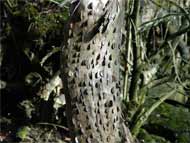  Who says "money doesn’t grow on trees"? There are places
in England where money apparently does just that. The people of Yorkshire, in the north of England are renowned for being careful with their money but on occasion they are willing to throw caution to the
wind and hammer their low denomination coinage into trees. Some trees have come to bear a marked resemblance to the torso of some sort of lizard with coins becoming its scales. It's almost Arthurian in its strangeness... What appears to be the background for a cheesy 80s album cover is actually
an untouched photo from Salar de Uyuni in Bolivia, the largest salt flat in the
world. It frequently floods with a shallow layer of water and is a popular tourist site for its natural beauty... Like insulation around wires, myelin is a fatty sheath that coats our nerve axons,
allowing for efficient conduction of nerve impulses - key to the fast processing speeds that underlie higher cognitive function and encoding of memories. The pervasive myelination of our brain is the
single most unique aspect in which the human brain differs from other species. Myelin is produced by oligodendrocytes - specialised glial cells that become more vulnerable with age. Myelination of
the brain follows an inverted U-shaped trajectory, growing strongly until our 50s, when it slowly begins to unravel as we age. The myelin deposited in adulthood ensheaths increasing numbers of axons with
smaller axon diameters and so spreads itself thinner and thinner. As a result, it becomes more susceptible to the ravages of age in the form of environmental and genetic insults and slowly begins to
break down faster than it can be repaired. Could this be what ultimately initiates the mechanisms
that produce degenerative diseases like Alzheimer's?... National Health Service (NHS) has released the first study of autism in the general adult population. The findings confirm the intuitive
assumption: autism spectrum disorder (ASD) is just as common in adults as it is in
children. Researchers working with the NHS Information Centre found that roughly 1 in 100 adults are on the spectrum — the same rate found for children in England, Japan, Canada and, for that matter,
New Jersey. This finding appears to contradict the commonplace idea that autism rates have exploded in the past two decades. Researchers found no significant differences in autism prevalence among
people they surveyed in their 20s, 30s, 40s, right up through their 70s. "This suggests that the factors that lead to developing autism appear to be constant." Who says "money doesn’t grow on trees"? There are places
in England where money apparently does just that. The people of Yorkshire, in the north of England are renowned for being careful with their money but on occasion they are willing to throw caution to the
wind and hammer their low denomination coinage into trees. Some trees have come to bear a marked resemblance to the torso of some sort of lizard with coins becoming its scales. It's almost Arthurian in its strangeness... What appears to be the background for a cheesy 80s album cover is actually
an untouched photo from Salar de Uyuni in Bolivia, the largest salt flat in the
world. It frequently floods with a shallow layer of water and is a popular tourist site for its natural beauty... Like insulation around wires, myelin is a fatty sheath that coats our nerve axons,
allowing for efficient conduction of nerve impulses - key to the fast processing speeds that underlie higher cognitive function and encoding of memories. The pervasive myelination of our brain is the
single most unique aspect in which the human brain differs from other species. Myelin is produced by oligodendrocytes - specialised glial cells that become more vulnerable with age. Myelination of
the brain follows an inverted U-shaped trajectory, growing strongly until our 50s, when it slowly begins to unravel as we age. The myelin deposited in adulthood ensheaths increasing numbers of axons with
smaller axon diameters and so spreads itself thinner and thinner. As a result, it becomes more susceptible to the ravages of age in the form of environmental and genetic insults and slowly begins to
break down faster than it can be repaired. Could this be what ultimately initiates the mechanisms
that produce degenerative diseases like Alzheimer's?... National Health Service (NHS) has released the first study of autism in the general adult population. The findings confirm the intuitive
assumption: autism spectrum disorder (ASD) is just as common in adults as it is in
children. Researchers working with the NHS Information Centre found that roughly 1 in 100 adults are on the spectrum — the same rate found for children in England, Japan, Canada and, for that matter,
New Jersey. This finding appears to contradict the commonplace idea that autism rates have exploded in the past two decades. Researchers found no significant differences in autism prevalence among
people they surveyed in their 20s, 30s, 40s, right up through their 70s. "This suggests that the factors that lead to developing autism appear to be constant."
Using computer graphics, faces of the opposite sex to the (heterosexual) participants were manipulated to look more or less like a sibling. The study subjects were then asked to assess the faces for
both trustworthiness and physical attractiveness. When tested for trustworthiness, subjects found
those that looked like them were more trustworthy than average, but when judging the
same faces for physical attractiveness, participants thought the similar faces were less attractive. Further, a good predictor of a potential partner’s hair and eye colour appears to be that of their
opposite sex parent. Also if subjects are born to young parents they tend to like young faces and if born to older parents they prefer older partner faces... The top 10 art deco buildings in New York (my favourite is the Chanin
Building... "The counsels of impatience and hatred can always be supported by the crudest and cheapest symbols; for the counsels of moderation, the reasons are often intricate rather than emotional
and difficult to explain. And so the chauvinists of all times and places go their appointed way, plucking the easy fruits, reaping the little triumphs of the day at the expense of someone else's
tomorrow, deluging in noise and filth anyone who gets in their way, dancing their reckless dance on the prospects for human progress, drawing the shadow of a great doubt over the validity of democratic
institutions. And until peoples learn to spot the fanning of mass emotions and the sowing of bitterness, suspicion, and intolerance as crimes in themselves – as perhaps the greatest disservice
that can be done to the cause of popular government – this sort of thing will continue to occur." - George kennan. American diplomat. (And it has. And it still is.)
  
Rodney was reading the morning newspaper when he came upon a study that said women use more words than men.
Excited to prove to his wife, Cathy, his long-held contention that women in general, and Cathy in particular, talked too much,
he showed her the study results. Rodney read the report to Cathy, "Men use about 15,000 words per day, but women use 30,000."
Cathy thought awhile, then finally she said to him, "It's because we have to repeat everything we say."
Rodney said, "What?"
  
All I want is the best of everything and there's very little of that left.
- Cecil Beaton

For other updates click "Home" (for the latest) or "Next" (for older) below
|
 Animals
Animals Animation
Animation Art of Playing Cards
Art of Playing Cards Drugs
Drugs Education
Education Environment
Environment Flying
Flying History
History Humour
Humour Immigration
Immigration Info/Tech
Info/Tech Intellectual/Entertaining
Intellectual/Entertaining Lifestyles
Lifestyles Men
Men Money/Politics/Law
Money/Politics/Law New Jersey
New Jersey Odds and Oddities
Odds and Oddities Older & Under
Older & Under Photography
Photography Prisons
Prisons Relationships
Relationships Science
Science Social/Cultural
Social/Cultural Terrorism
Terrorism Wellington
Wellington Working
Working Zero Return Investment
Zero Return Investment


































